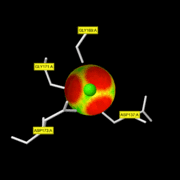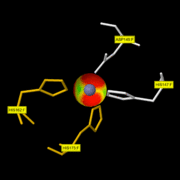Sandbox Reserved 1125
From Proteopedia
| Line 52: | Line 52: | ||
=== Hemopexin domain === | === Hemopexin domain === | ||
The hemopexin domain has two conserved cysteines that are disulfide bonded. Mutation of those cysteines to alanines <ref>PMID:8464863</ref> or reduction and alkylation destroys collagenolytic activity (K. Suzuki and H.Nagase, unpublished results).<ref name="Pdf"/> | The hemopexin domain has two conserved cysteines that are disulfide bonded. Mutation of those cysteines to alanines <ref>PMID:8464863</ref> or reduction and alkylation destroys collagenolytic activity (K. Suzuki and H.Nagase, unpublished results).<ref name="Pdf"/> | ||
| + | It is essential for the substrate recognition of MMP-8 and the single catalytic domain of MMP-8 is not able to cleave collagen. When this hemopexin-like domain is removed, the protein loses its ability to cleave collagen. However, neutrophil collagenase is still able to cleave other substrate. | ||
| + | It seems that the collagen binds to two sites on MMP-8 : one in the catalytic site and another in the hemopexin domain. One hypothesis is that when the collagen binds to both sites, its helical structure is destabilized and unwound. Thus, the cleavage site of collagen is accessible and the cleavage reaction can occur.[http://www.jleukbio.org/content/81/4/870.full] | ||
| + | |||
| + | Unfortunately, no structure of the full MMP8 protein have been crystallized yet, but <scene name='71/719866/Human_prommp-1_structure/1'>here</scene> you can see in orange the hemopexin domain of human pro-MMP1 which is very well conserved between these two proteins, by the way you can find in this article: [http://www.fasebj.org/content/12/12/1075.full#ref-27 Matrix metalloproteinases: structures, evolution, and diversification,Irina Massova, Lakshmi P. Kotra, Rafael Fridman and Shahriar Mobashery], good pieces of information on conservations among the MMPs family. | ||
| - | [http://www.jleukbio.org/content/81/4/870.full] | ||
| - | This domain is localized outside of the catalytic domain shown in this page. It is essential for the substrate recognition of MMP-8 and the single catalytic domain of MMP-8 is not able to cleave collagen. When this hemopexin-like domain is removed, the protein loses its ability to cleave collagen. However, neutrophil collagenase is still able to cleave other substrate. | ||
| - | It seems that the collagen binds to two sites on MMP-8 : one in the catalytic site and another in the hemopexin domain. One hypothesis is that when the collagen binds to both sites, its helical structure is destabilized and unwound. Thus, the cleavage site of collagen is accessible and the cleavage reaction can occur. | ||
Revision as of 14:51, 30 January 2016
Matrix metalloproteinase-8
MMP-8, also called, Neutrophil collagenase or Collagenase 2, is a zinc-dependent and calcium-dependent enzyme. It belongs to the Matrix metalloproteinase (MMP) family which is involved in the breakdown of extracellular matrix in embryonic development, reproduction, and tissue remodeling, as well as in disease processes. The gene coding this family is localized on the chromosome 11 of Homo sapiens with 467 residues.[1]
is the initial structure of the catalytic domain of MMP-8.
| |||||||||||
References
- ↑ "MMP-8 matrix metallopeptidase 8 (neutrophil collagenase)"
- ↑ "Metalloendopeptidase activity"
- ↑ Stams T, Spurlino JC, Smith DL, Wahl RC, Ho TF, Qoronfleh MW, Banks TM, Rubin B. Structure of human neutrophil collagenase reveals large S1' specificity pocket. Nat Struct Biol. 1994 Feb;1(2):119-23. PMID:7656015
- ↑ 4.0 4.1 Substrate specificity of MMPs
- ↑ Bode W, Reinemer P, Huber R, Kleine T, Schnierer S, Tschesche H. The X-ray crystal structure of the catalytic domain of human neutrophil collagenase inhibited by a substrate analogue reveals the essentials for catalysis and specificity. EMBO J. 1994 Mar 15;13(6):1263-9. PMID:8137810
- ↑ On this you can only see the 3 His of MMP-8 with the Zn999. The fourth ligand of the catalytic zinc is a water molecule.
Zn998 : the structural zinc
The residues involved in the Zn998 interactions are . The glutamic acid adjacent to the first histidine is essential for catalysis. It should be noted that scientists were unable to exchange or remove this Zinc in their crystals, which is suggesting that there is a tight interaction with MMP-8.<ref>
=== Hinge domain === It corresponds to a short linker region from G242 to P258, with the following sequence: GLSSNPIQPTGPSTPKP, between the catalytic and the hemopexin domains. The exact role of this domain isn't very well clear but it's known that autoproteolysis could occurred in MMP8 leading to an unstable protein and different mutants<ref>PMID:9094424</li> <li id="cite_note-6">[[#cite_ref-6|↑]] Hirose T, Patterson C, Pourmotabbed T, Mainardi CL, Hasty KA. Structure-function relationship of human neutrophil collagenase: identification of regions responsible for substrate specificity and general proteinase activity. Proc Natl Acad Sci U S A. 1993 Apr 1;90(7):2569-73. PMID:[http://www.ncbi.nlm.nih.gov/pubmed/8464863 8464863] </li> <li id="cite_note-7">[[#cite_ref-7|↑]] Van Wart HE, Birkedal-Hansen H. The cysteine switch: a principle of regulation of metalloproteinase activity with potential applicability to the entire matrix metalloproteinase gene family. Proc Natl Acad Sci U S A. 1990 Jul;87(14):5578-82. PMID:[http://www.ncbi.nlm.nih.gov/pubmed/2164689 2164689] </li> <li id="cite_note-8">[[#cite_ref-8|↑]] Chung L, Dinakarpandian D, Yoshida N, Lauer-Fields JL, Fields GB, Visse R, Nagase H. Collagenase unwinds triple-helical collagen prior to peptide bond hydrolysis. EMBO J. 2004 Aug 4;23(15):3020-30. Epub 2004 Jul 15. PMID:[http://www.ncbi.nlm.nih.gov/pubmed/15257288 15257288] doi:[http://dx.doi.org/10.1038/sj.emboj.7600318 http://dx.doi.org/10.1038/sj.emboj.7600318]</li> <li id="cite_note-9">[[#cite_ref-9|↑]] Piccard H, Van den Steen PE, Opdenakker G. Hemopexin domains as multifunctional liganding modules in matrix metalloproteinases and other proteins. J Leukoc Biol. 2007 Apr;81(4):870-92. Epub 2006 Dec 21. PMID:[http://www.ncbi.nlm.nih.gov/pubmed/17185359 17185359] doi:[http://dx.doi.org/10.1189/jlb.1006629 http://dx.doi.org/10.1189/jlb.1006629]</li> <li id="cite_note-10">[[#cite_ref-10|↑]] Visse R, Nagase H. Matrix metalloproteinases and tissue inhibitors of metalloproteinases: structure, function, and biochemistry. Circ Res. 2003 May 2;92(8):827-39. PMID:[http://www.ncbi.nlm.nih.gov/pubmed/12730128 12730128] doi:[http://dx.doi.org/10.1161/01.RES.0000070112.80711.3D http://dx.doi.org/10.1161/01.RES.0000070112.80711.3D]</li> <li id="cite_note-11">[[#cite_ref-11|↑]] Knauper V, Docherty AJ, Smith B, Tschesche H, Murphy G. Analysis of the contribution of the hinge region of human neutrophil collagenase (HNC, MMP-8) to stability and collagenolytic activity by alanine scanning mutagenesis. FEBS Lett. 1997 Mar 17;405(1):60-4. PMID:[http://www.ncbi.nlm.nih.gov/pubmed/9094424 9094424] </li> <li id="cite_note-12">[[#cite_ref-12|↑]] [http://www.ebi.ac.uk/interpro/entry/IPR028709 "Neutrophil collagenase"]</li> <li id="cite_note-13">[[#cite_ref-13|↑]] Visse R, Nagase H. Matrix metalloproteinases and tissue inhibitors of metalloproteinases: structure, function, and biochemistry. Circ Res. 2003 May 2;92(8):827-39. PMID:[http://www.ncbi.nlm.nih.gov/pubmed/12730128 12730128] doi:[http://dx.doi.org/10.1161/01.RES.0000070112.80711.3D http://dx.doi.org/10.1161/01.RES.0000070112.80711.3D]</li> <li id="cite_note-14">[[#cite_ref-14|↑]] Nagase H, Visse R, Murphy G. Structure and function of matrix metalloproteinases and TIMPs. Cardiovasc Res. 2006 Feb 15;69(3):562-73. Epub 2006 Jan 5. PMID:[http://www.ncbi.nlm.nih.gov/pubmed/16405877 16405877] doi:[http://dx.doi.org/10.1016/j.cardiores.2005.12.002 http://dx.doi.org/10.1016/j.cardiores.2005.12.002]</li> <li id="cite_note-15">[[#cite_ref-15|↑]] [http://www.rcsb.org/pdb/explore/explore.do?structureId=1UEA "Metalloprotease-Inhibitor Complex</li> <li id="cite_note-16">[[#cite_ref-16|↑]] Brew K, Nagase H. The tissue inhibitors of metalloproteinases (TIMPs): an ancient family with structural and functional diversity. Biochim Biophys Acta. 2010 Jan;1803(1):55-71. doi: 10.1016/j.bbamcr.2010.01.003. , Epub 2010 Jan 15. PMID:[http://www.ncbi.nlm.nih.gov/pubmed/20080133 20080133] doi:[http://dx.doi.org/10.1016/j.bbamcr.2010.01.003 http://dx.doi.org/10.1016/j.bbamcr.2010.01.003]</li> <li id="cite_note-17">[[#cite_ref-17|↑]] Jacobsen JA, Major Jourden JL, Miller MT, Cohen SM. To bind zinc or not to bind zinc: an examination of innovative approaches to improved metalloproteinase inhibition. Biochim Biophys Acta. 2010 Jan;1803(1):72-94. doi: 10.1016/j.bbamcr.2009.08.006. , Epub 2009 Aug 25. PMID:[http://www.ncbi.nlm.nih.gov/pubmed/19712708 19712708] doi:[http://dx.doi.org/10.1016/j.bbamcr.2009.08.006 http://dx.doi.org/10.1016/j.bbamcr.2009.08.006]</li> <li id="cite_note-18">[[#cite_ref-18|↑]] http://www.rcsb.org/pdb/explore/explore.do?structureId=1ZP5</li> <li id="cite_note-19">[[#cite_ref-19|↑]] http://www.rcsb.org/pdb/explore/explore.do?structureId=3DPE</li> <li id="cite_note-20">[[#cite_ref-20|↑]] [http://www.enzim.hu/~lbarna/articles/19173605.pdf "Extra Binding Region Induced by Non-Zinc Chelating Inhibitors into the S1′ Subsite of Matrix Metalloproteinase 8"]</li> <li id="cite_note-21">[[#cite_ref-21|↑]] Savill NJ, Weller R, Sherratt JA. Mathematical modelling of nitric oxide regulation of rete peg formation in psoriasis. J Theor Biol. 2002 Jan 7;214(1):1-16. PMID:[http://www.ncbi.nlm.nih.gov/pubmed/11786028 11786028] doi:[http://dx.doi.org/10.1006/jtbi.2001.2400 http://dx.doi.org/10.1006/jtbi.2001.2400]</li> <li id="cite_note-22">[[#cite_ref-22|↑]] Larochelle C, Alvarez JI, Prat A. How do immune cells overcome the blood-brain barrier in multiple sclerosis? FEBS Lett. 2011 Dec 1;585(23):3770-80. doi: 10.1016/j.febslet.2011.04.066. Epub, 2011 May 4. PMID:[http://www.ncbi.nlm.nih.gov/pubmed/21550344 21550344] doi:[http://dx.doi.org/10.1016/j.febslet.2011.04.066 http://dx.doi.org/10.1016/j.febslet.2011.04.066]</li> <li id="cite_note-23">[[#cite_ref-23|↑]] Westermarck J, Kahari VM. Regulation of matrix metalloproteinase expression in tumor invasion. FASEB J. 1999 May;13(8):781-92. PMID:[http://www.ncbi.nlm.nih.gov/pubmed/10224222 10224222] </li> <li id="cite_note-24">[[#cite_ref-24|↑]] Liu KZ, Hynes A, Man A, Alsagheer A, Singer DL, Scott DA. Increased local matrix metalloproteinase-8 expression in the periodontal connective tissues of smokers with periodontal disease. Biochim Biophys Acta. 2006 Aug;1762(8):775-80. Epub 2006 Jul 22. PMID:[http://www.ncbi.nlm.nih.gov/pubmed/16928431 16928431] doi:[http://dx.doi.org/10.1016/j.bbadis.2006.05.014 http://dx.doi.org/10.1016/j.bbadis.2006.05.014]</li> <li id="cite_note-25">[[#cite_ref-25|↑]] Balbin M, Fueyo A, Knauper V, Pendas AM, Lopez JM, Jimenez MG, Murphy G, Lopez-Otin C. Collagenase 2 (MMP-8) expression in murine tissue-remodeling processes. Analysis of its potential role in postpartum involution of the uterus. J Biol Chem. 1998 Sep 11;273(37):23959-68. PMID:[http://www.ncbi.nlm.nih.gov/pubmed/9727011 9727011] </li> <li id="cite_note-26">[[#cite_ref-26|↑]] Brand KH, Ahout IM, de Groot R, Warris A, Ferwerda G, Hermans PW. Use of MMP-8 and MMP-9 to assess disease severity in children with viral lower respiratory tract infections. J Med Virol. 2012 Sep;84(9):1471-80. doi: 10.1002/jmv.23301. PMID:[http://www.ncbi.nlm.nih.gov/pubmed/22825827 22825827] doi:[http://dx.doi.org/10.1002/jmv.23301 http://dx.doi.org/10.1002/jmv.23301]</li>
<li id="cite_note-27">[[#cite_ref-27|↑]] Gao M, Nguyen TT, Suckow MA, Wolter WR, Gooyit M, Mobashery S, Chang M. Acceleration of diabetic wound healing using a novel protease-anti-protease combination therapy. Proc Natl Acad Sci U S A. 2015 Dec 8;112(49):15226-31. doi:, 10.1073/pnas.1517847112. Epub 2015 Nov 23. PMID:[http://www.ncbi.nlm.nih.gov/pubmed/26598687 26598687] doi:[http://dx.doi.org/10.1073/pnas.1517847112 http://dx.doi.org/10.1073/pnas.1517847112]</li></ol></ref>
RESSOURCE : Image:2oy4 mm1.pdb ( la structure du monomère )


